- Afrikaans
- Albanian
- Amharic
- Arabic
- Armenian
- Azerbaijani
- Basque
- Belarusian
- Bengali
- Bosnian
- Bulgarian
- Catalan
- Cebuano
- Corsican
- Croatian
- Czech
- Danish
- Dutch
- English
- Esperanto
- Estonian
- Finnish
- French
- Frisian
- Galician
- Georgian
- German
- Greek
- Gujarati
- Haitian Creole
- hausa
- hawaiian
- Hebrew
- Hindi
- Miao
- Hungarian
- Icelandic
- igbo
- Indonesian
- irish
- Italian
- Japanese
- Javanese
- Kannada
- kazakh
- Khmer
- Rwandese
- Korean
- Kurdish
- Kyrgyz
- Lao
- Latin
- Latvian
- Lithuanian
- Luxembourgish
- Macedonian
- Malgashi
- Malay
- Malayalam
- Maltese
- Maori
- Marathi
- Mongolian
- Myanmar
- Nepali
- Norwegian
- Norwegian
- Occitan
- Pashto
- Persian
- Polish
- Portuguese
- Punjabi
- Romanian
- Russian
- Samoan
- Scottish Gaelic
- Serbian
- Sesotho
- Shona
- Sindhi
- Sinhala
- Slovak
- Slovenian
- Somali
- Spanish
- Sundanese
- Swahili
- Swedish
- Tagalog
- Tajik
- Tamil
- Tatar
- Telugu
- Thai
- Turkish
- Turkmen
- Ukrainian
- Urdu
- Uighur
- Uzbek
- Vietnamese
- Welsh
- Bantu
- Yiddish
- Yoruba
- Zulu
Nov . 09, 2024 01:54 Back to list
Designing Concrete Foundations for Metal Buildings
When constructing metal buildings, the foundation plays a vital role in ensuring the structure’s stability, durability, and overall performance. A solid concrete foundation is fundamental for any metal structure, as it provides the necessary support to withstand various loads and environmental factors. Here, we explore the essential elements, considerations, and best practices in designing concrete foundations specifically for metal buildings.
Understanding Load Requirements
The primary step in designing a concrete foundation is understanding the load requirements of the metal building. These loads can include the dead load (the weight of the building materials), live load (furniture, equipment, and occupants), wind load, and seismic load. Each of these factors must be calculated to ensure the foundation is adequately designed to support the metal structure without excessive settlement or failure. Consulting with a structural engineer is advisable, as they can provide insights into local building codes and load requirements specific to the site conditions.
Choosing the Right Foundation Type
There are several types of concrete foundations that can be used for metal buildings, including slab-on-grade, trench foundations, and piers.
1. Slab-On-Grade Foundations This type involves pouring a thick concrete mat that serves as both the floor and foundation. It is ideal for buildings on stable, dry soils and where the frost line is not a concern.
2. Trench Foundations Suitable for areas with expansive soils or where frost depth is a consideration, trench foundations involve digging deep trenches and pouring concrete. They provide a robust base for taller or heavier structures.
metal building concrete foundation design

3. Pier Foundations Piers are used when the soil has a low bearing capacity or when the building requires a raised foundation. These involve placing concrete columns deep into the ground to support the weight of the building above.
Soil Considerations
Before finalizing the foundation design, it’s crucial to conduct a soil analysis. The soil type, bearing capacity, and drainage capabilities greatly influence the design and choice of the foundation. Clay, sandy soil, and rocky terrain each present different challenges, necessitating tailored solutions. Proper drainage is also essential to prevent water accumulation that could weaken the foundation over time.
Reinforcement and Insulation
Concrete itself is strong in compression but weak in tension, which is why reinforcing materials such as steel rebar or wire mesh are often integrated into the foundation design. These reinforcements help prevent cracking and enhance the structural integrity of the foundation. Furthermore, insulation may also be incorporated, particularly in slab foundations, to protect against thermal fluctuations and moisture issues.
Conclusion
In conclusion, the design of concrete foundations for metal buildings is a critical process that requires careful consideration of various factors, including load requirements, soil conditions, and foundation type. By understanding these elements and adhering to best practices, builders can ensure a solid foundation that maximizes the longevity and safety of metal structures. Close collaboration with engineers and adherence to local building codes will further enhance the success of the foundation design, ultimately leading to a strong and resilient metal building.
-
How Do Prefabricated Steel Structures Transform Modern Construction?
NewsJul.14,2025
-
How Do Prefabricated Metal Buildings Redefine Modern Construction?
NewsJul.14,2025
-
How Do Prefab Insulated Metal Buildings and Steel Structures Revolutionize Modern Construction?
NewsJul.14,2025
-
How Do Pre - Engineered Steel Structures Redefine Modern Construction?
NewsJul.14,2025
-
Advancing Modular Construction with Prefabricated Metal Structures
NewsJul.14,2025
-
Advancing Industrial Infrastructure with Prefabricated Steel Solutions
NewsJul.14,2025
Products categories
Our Latest News
We have a professional design team and an excellent production and construction team.












